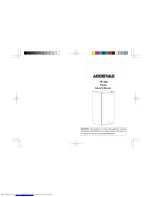
This appliance contains
hydrocarbons in its cooling
unit; maintenance and
recharging must therefore
only be carried out by
authorized technicians.
The accessories and parts of
the appliance are not
suitable for washing in a
dishwasher.
6.2
Cleaning the interior
Before using the appliance for the first
time, the interior and all internal
accessories should be washed with
lukewarm water and some neutral soap
to remove the typical smell of a brand-
new product, then dried thoroughly.
CAUTION!
Do not use detergents,
abrasive powders, chlorine
or oil-based cleaners as they
will damage the finish.
6.3
Periodic cleaning
CAUTION!
Do not pull, move or
damage any pipes and/or
cables inside the cabinet.
CAUTION!
Take care of not to damage
the cooling system.
CAUTION!
When moving the cabinet,
lift it by the front edge to
avoid scratching the floor.
The equipment has to be cleaned
regularly:
1.
Clean the inside and accessories with
lukewarm water and some neutral
soap.
2.
Regularly check the door seals and
wipe clean to ensure they are clean
and free from debris.
3.
Rinse and dry thoroughly.
4.
If accessible, clean the condenser
and the compressor at the back of
the appliance with a brush.
This operation will improve the
performance of the appliance and
save electricity consumption.
6.4
Defrosting of the freezer
The freezer compartment is frost free.
This means that there is no build up of
frost when it is in operation, neither on
the internal walls, nor on the foods.
6.5
Periods of non-operation
When the appliance is not in use for long
periods, take the following precautions:
1.
Disconnect the appliance from
electricity supply.
2.
Remove all food.
3.
Clean the appliance and all
accessories.
4.
Leave the door/doors open to
prevent unpleasant smells.
WARNING!
If you want to keep the
appliance switched on, ask
somebody to check it once
in a while to prevent the
food inside from spoiling in
case of a power failure.
7.
TROUBLESHOOTING
WARNING!
Refer to Safety chapters.
www.aeg.com
10


































